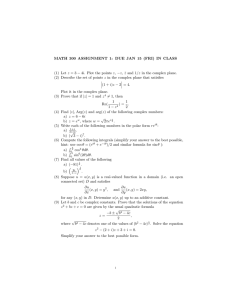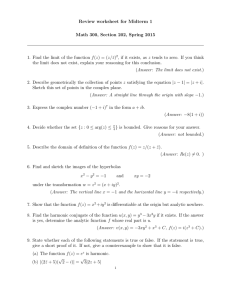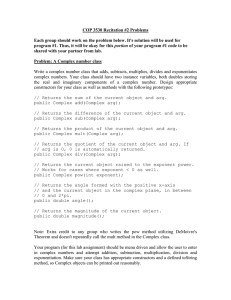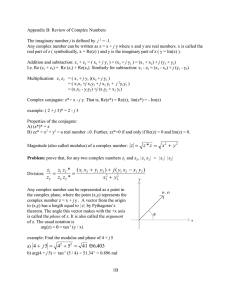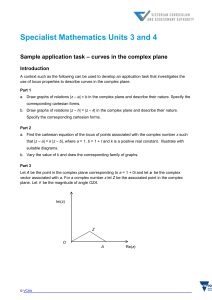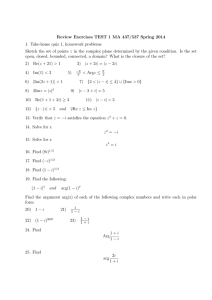Rotation Theorem Explained: Complex Analysis & Coni Method
advertisement
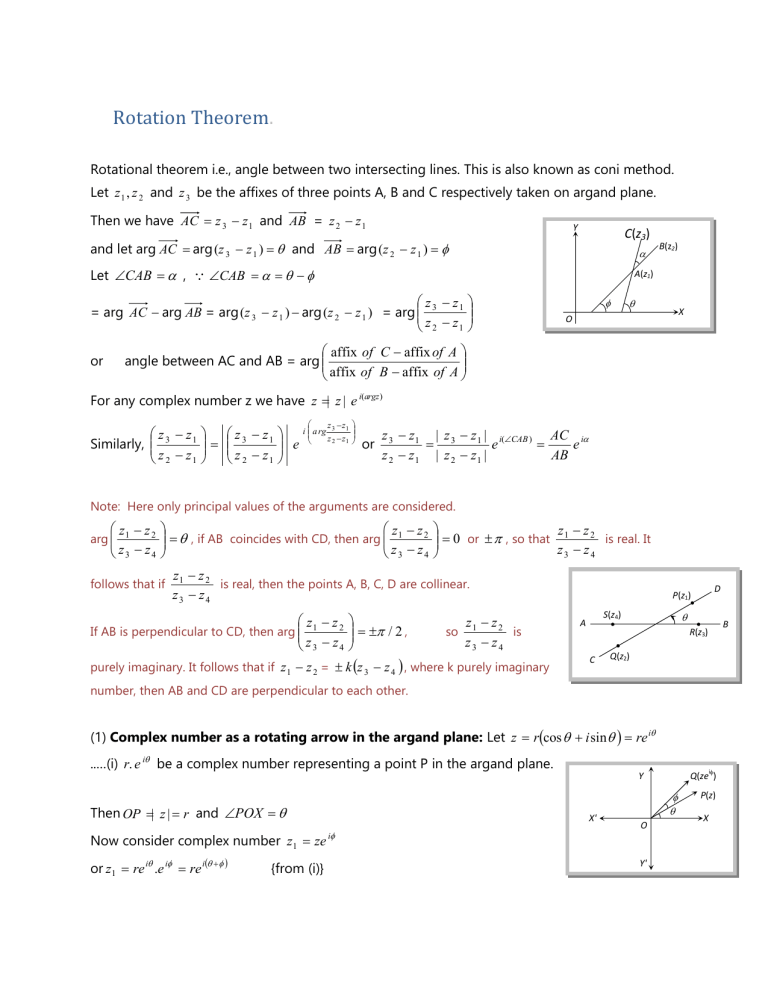
Rotation Theorem.
Rotational theorem i.e., angle between two intersecting lines. This is also known as coni method.
Let z 1 , z 2 and z 3 be the affixes of three points A, B and C respectively taken on argand plane.
Then we have AC z 3 z 1 and AB = z 2 z 1
Y
C(z3)
and let arg AC arg (z 3 z 1 ) and AB arg (z 2 z 1 )
Let CAB , CAB
B(z2)
A(z1)
z z1
= arg AC arg AB = arg (z 3 z 1 ) arg (z 2 z 1 ) = arg 3
z
z
2
1
X
O
affix of C affix of A
angle between AC and AB = arg
affix of B affix of A
or
For any complex number z we have z | z | e i(argz )
z z1
Similarly, 3
z 2 z1
z 3 z1
z 3 z 1 i a rg z 2 z1
z z 1 | z 3 z 1 | i(CAB ) AC i
e
e
e
or 3
z 2 z 1 | z 2 z1 |
AB
z 2 z1
Note: Here only principal values of the arguments are considered.
z1 z 2
z z2
z z2
, if AB coincides with CD, then arg 1
0 or , so that 1
is real. It
z3 z4
z3 z4
z3 z4
arg
follows that if
z1 z 2
is real, then the points A, B, C, D are collinear.
z3 z4
z1 z 2
/ 2 ,
z3 z4
If AB is perpendicular to CD, then arg
so
z1 z 2
is
z3 z4
purely imaginary. It follows that if z 1 z 2 = k z 3 z 4 , where k purely imaginary
D
P(z1)
S(z4)
A
R(z3)
C
Q(z2)
number, then AB and CD are perpendicular to each other.
(1) Complex number as a rotating arrow in the argand plane: Let z rcos i sin re i
..…(i) r. e i be a complex number representing a point P in the argand plane.
Then OP | z | r and POX
Now consider complex number z1 ze i
or z1 re i .e i re i
{from (i)}
Q(zei)
Y
X'
O
Y'
P(z)
X
B
Clearly the complex number z1 represents a point Q in the argand plane, when OQ r and
QOX .
Clearly multiplication of z with e i rotates the vector OP through angle in anticlockwise
sense.
Similarly multiplication of z with e i will rotate the vector OP in clockwise sense.
Note: If z 1 , z 2 and z 3 are the affixes of the points A,B and C such that AC AB and CAB .
Therefore, AB z 2 z1 , AC z 3 z1 .
C(z3)
Then AC will be obtained by rotating AB through an angle in anticlockwise
B(z2)
sense, and therefore,
AC AB e i or (z 3 z1 ) (z 2 z1 )e i or
A(z1)
z 3 z1
e i
z 2 z1
If A, B and C are three points in argand plane such that AC AB and CAB then use the
rotation about A to find e i , but if AC AB use coni method.
Let z1 and z 2 be two complex numbers represented by point P and Q in the argand plane such
that POQ . Then, z1e i is a vector of magnitude | z 1 | OP along OQ and
vector along OQ . Consequently, | z 2 | .
z2
z1 e i
is a unit
| z1 |
z1 e i
is a vector of magnitude | z 2 | OQ along OQ i.e.,
| z1 |
| z2 |
z
.z1e i z 2 2 .
| z1 |
z1
(2) Condition for four points to be noncyclic:If points A,B,C and D are concyclic
ABD ACD
Using rotation theorem
(z z 3 ) z 4 z 3 i
In ACD 1
e
z1 z 3
z4 z3
From (i) and (ii)
D(z4)
A(z1)
(z z 2 ) z 4 z 2 i
In ABD 1
e
z1 z 2
z4 z2
.....(i)
.....(ii)
B(z2)
C(z3)
(z 1 z 2 ) (z 4 z 3 ) (z 1 z 2 ) (z 4 z 3 )
=Real
z1 z 3 z 4 z 2
(z 1 z 3 ) (z 4 z 2 )
So if z 1 , z 2 , z 3 and z 4 are such that
(z 1 z 2 ) (z 4 z 3 )
is real, then these four points are concyclic.
(z 1 z 3 ) (z 4 z 2 )
